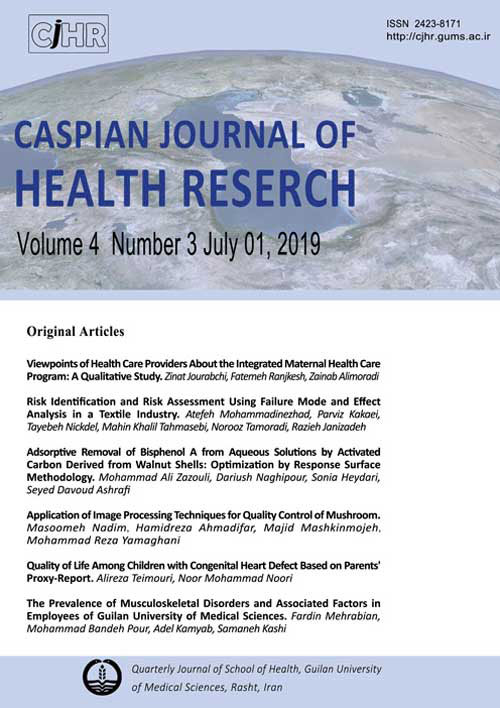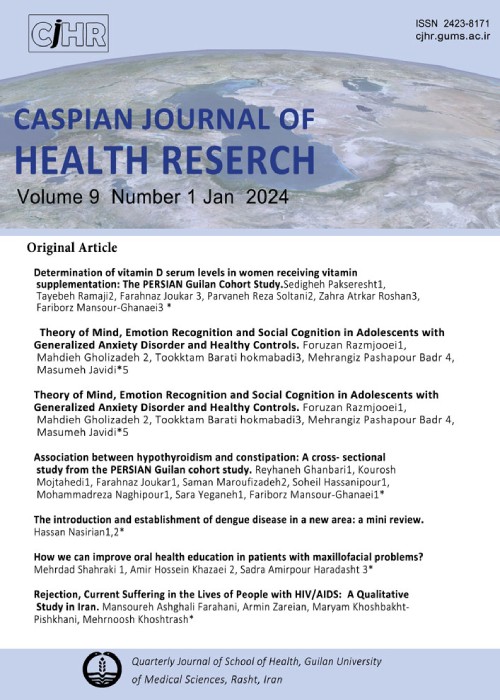فهرست مطالب

Caspian Journal of Health Research
Volume:6 Issue: 3, Sep 2021
- تاریخ انتشار: 1400/08/27
- تعداد عناوین: 4
-
-
Pages 73-80Background
Medical students, as part of the healthcare team, are directly exposed to challenging conditions during the COVID-19 epidemic. This study investigated COVID-19 anxiety, burnout, and academic achievement in stagers and interns of Guilan University of Medical Sciences.
Materials & MethodsThe present analytical cross-sectional study was conducted on medical students and interns studying at Guilan University of Medical Sciences in the 2020-2021 academic year. Of whom, 150 students participated in this study. Corona Disease Anxiety Scale (CDAS) and Maslach Burnout Inventory-Student Survey (MBI-SS) were used to measure anxiety and academic burnout of the students, respectively. Measuring students’ academic achievement was based on Grade Point Average (GPA). Data analysis was performed using chi-square, Mann-Whitney U test, and partial Spearman correlation Coefficient.
ResultsThe participation rate in this study was 92%. The results showed that 6.5% of students had high anxiety, 18.8% reported high academic burnout, and 79% reported the average level of burnout score. Also, the participants’ GPA was 16.76±1.30. The academic burnout score was significantly higher in male students than female ones (t=-2.01; P=0.04). The GPA was significantly higher in students under 24 years old than in older students (t=4.71; P=0.01). The partial correlation coefficient adjusted for sex showed a positive and significant correlation between CDAS and MBI-SS (r=0.346; P<0.001).
ConclusionThe present study results showed that medical stagers and intern students had high academic burnout during the COVID-19 epidemic, and there was a weak and direct correlation between academic burnout and COVID-19 anxiety. Accordingly, to reduce the consequences of the COVID-19 epidemic, appropriate therapeutic and educational interventions should be provided to empower stagers and intern students.
Keywords: COVID-19, Anxiety, burnout, Academic achievement, Medical students -
Pages 81-90Background
Psychological factors affect marital conflict and happiness; in other words, they strengthen and shape marital relations. The present study aimed to investigate the effectiveness of training based on Healthy Human Theory (HHT) and Emotion-Focused Therapy (EFT) in marital happiness of couples living in Isfahan City, Iran.
Materials & MethodsThis research has a pretest-posttest control group design. The statistical population included all couples referring to mental health centers in Isfahan in 2020. The study sample consisted of 39 couples selected by the convenience sampling method. The participants were randomly divided into two experimental groups (training based on HHT and EFT) and control group (n=13 couples per group). The research instrument included
the marital satisfaction scale. Follow-up was performed after 90 days. Repeated-measures ANOVA in SPSS software was used to analyze the data.ResultsThe results showed that training based on HHT significantly affected marital happiness compared to EFT and control group (P=0.001). The Mean±SD of the posttest scores of marital happiness in the HHT-based training, EFT, and control groups were 97.92±1.54, 87.50±5.56, and 75.38±8.71, respectively. There was no significant difference between the effects of HHT-based training and EFT on happiness in couples.
ConclusionBased on the results, the HHT-based training and EFT are appropriate methods for improving marital happiness.
Keywords: Healthy human theory, Emotion-focused therapy, Happiness, Couples -
Prevalence of Mental disorders among Children and Teenagers in Sistan and Baluchestan Province, IranPages 91-100Background
Paying attention to psychiatric disorder in childhood and adolescence is critical. It causes the occurrence of mental disorders in adulthood. The present study aimed to explore the frequency of mental disorders among children and adolescents in Zahedan City, Iran.
Materials & MethodsThis was a descriptive and cross-sectional study. Individuals aged between 6 and 18 years were included in this investigation. In total, 1003 children and adolescents were selected by the random cluster sampling method. To collect the required information, in addition to demographicinformation, the Schedule for Affective Disorders and Schizophrenia (K-SADS-PL) for school-age Children-Present and Lifetime version was employed. The obtained data were analyzed using multivariate logistic regression method.
ResultsA total of 1003 children and adolescents participated in the study; of them, 489 (48.8%) and 514(51.2%) were males and females, respectively. The Mean±SD age of study participants was 11.96±3.99 years. Moreover, 86.8% of the study subjects were from urban areas and 13.2% from rural areas. The highest prevalence of psychiatric disorders concerned behavioral disorders (6.8%); anxiety disorders (6.7%); The lowest prevalence were related to post-traumatic stress disorder (0.2%) and autism (0.1%). The overall prevalence of psychiatric disorder among children and adolescence was 14.4%.
ConclusionThis study found a high prevalence of psychiatric disorders similar to previous studies in the same age groups. The estimates played an important role in designing useful programs and interventions.
Keywords: Epidemiology, Psychiatric Disorders, Children, Teenagers -
Pages 101-108Background
Burns are the second most common etiology of injury death in children under 5 years old and are the most common cause of death in a home accident.
Materials & MethodsThis study was performed to investigate the epidemiology of childhood burn in children under 16 years old referred to Velayat Burn Center, Rasht City, Iran, from 2013 to 2018. Data were collected from electronic hospital records of burn patients aged under 16 years of age.
ResultsOut of 717 patients, 44.5% were girls, and 55.5% were boys (sex ratio=1.2). The highest frequency of burns (56.1%) was reported in the 1-5 years age group. The most common cause of burn was scalds (76%), and the most common burn severity was second-degree burns (46.7%). The Mean±SD duration of hospitalization was 3.07±4.15 days, and the hospital stay was significantly associated with the cause of the burn, Burned Body Surface Area (BBSA), and burn severity. The highest frequency was reported on Saturdays, i.e., (the first working day in Iran) (22.7%), between 6 and 12 o’clock (42.8%).
ConclusionThis study found that children in 1-5 years old were the most susceptible age group for burn injuries and scalds were the most common cause of the burn. The male to female ratio was 1.2, and the majority of burns occurred in the winter.
Keywords: Burn, Pediatric, Epidemiology, Childhood


